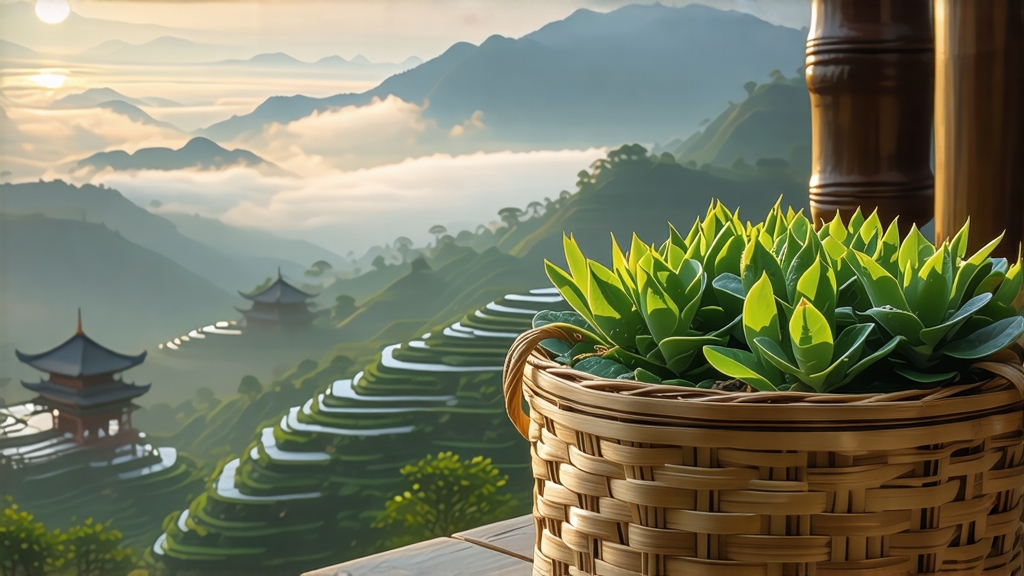
Meng Ding Huang Ya, literally “the yellow bud of Meng Summit,” is the least-known yet most aristocratic member of China’s yellow-tea family. While green tea commands global fame and pu-erh fills investment portfolios, this luminous liquor from the mist-crowned peaks of Ya’an, Sichuan, has quietly preserved the slow-food ethos of Chinese tea for twelve centuries. To understand it is to witness a vanished dynasty’s palate, a micro-terroir suspended in time, and a craft so precarious that fewer than thirty families still master it.
-
A leaf born of poetry and politics
The first written record appears in the Tang dynasty (806 CE) when the poet-priest Meng Jiao praised “golden shoots plucked before the Qingming rain.” By the Song era the buds were already taxed as “tribute tea,” carried by mule down the Min River to Chengdu, then by imperial courier to Xi’an and Kaifeng. When the Mongol horde swept through Sichuan in 1253 the gardens were burned; miraculously, three ancient shrubs survived inside the stone cloister of Meng Ding monastery. Their descendants, now protected by UNESCO, still provide the genetic stock for every authentic batch. In 1959 Premier Zhou Enlai served Meng Ding Huang Ya to Ho Chi Minh, sealing its diplomatic nickname “the handshake leaf.” Yet the Cultural Revolution’s push for mass production almost erased the slow yellowing craft; only a clandestine circle of monks and one village headman kept the knowledge alive in bamboo-slatted attics. -
Terroir above the clouds
Meng Summit rises to 1,456 m where the Sichuan basin collides with the Tibetan Plateau. Warm, wet monsoon air ascends the cliff faces, cooling 0.6 °C every hundred metres and condensing into a 280-day-a-year fog. The result is a dwarfed yet hyper-aromatic tea plant—Camellia sinensis var. sinensis cv. Meng Ding—whose two-centimetre spring buds develop only seven cells of chlorophyll, giving them a translucent jade heart. The soil is a tri-layer cake: Permian sandstone on bedrock, a middle stratum of ancient river loam rich in selenium, and a top blanket of pine-needle humus so acidic (pH 4.1) that aluminium ions turn the young leaves’ underside silvery. Locals insist the mountain’s name, “Meng,” meaning “misty dream,” is onomatopoeic: you hear the fog before you see it, a soft hush that sweetens every bud. -
The six-day men huang ritual
Yellow tea’s defining step is men huang—“sealing yellow”—a controlled re-absorption of moisture that edges the leaf from grassy green to chamomile gold without ever reaching the microbial ripeness of black tea. Masters begin at 03:40 on the first day, picking only the “sparrow-tongue” standard: unopened bud plus half-emerged first leaf, weight 0.18 g, still cloaked in dawn dew. The leaves are then spread on ramie cloth in a courtyard kept at 22 °C and 68 % RH for 70 minutes, allowing surface water to evaporate while internal turgor remains—what artisans call “alive but not awake.”
Next comes sha qing, the kill-green, but here it is a flirtation rather than a marriage: wok temperature is held at an unusually low 140 °C for four minutes, just enough to rupture 60 % of the oxidative enzymes. The leaf retains a stubborn 12 % moisture, critical for the forthcoming yellowing. Immediately after, while still hotter than a fresh croissant, the shoots are piled into a bamboo drum lined with wet cotton and left for three hours. Enzymes, now half-alive, consume residual chlorophyll and convert flavonols into the yellow pigment lutein, while amino acids condense into the honeyed compound 2-acetyl-1-pyrroline—the same aroma molecule that gives Indian basmati rice its popcorn note.
Days two to four are a choreography of rest and re-warming. Every eight hours the pile is fluffed, sprayed with mountain spring water at 38 °C, then re-covered. On the morning of day five the leaf has turned the colour of antique parchment; a master will pinch a bud and listen for the “silk snap,” a high-pitched crack that signals the cell walls have yellow